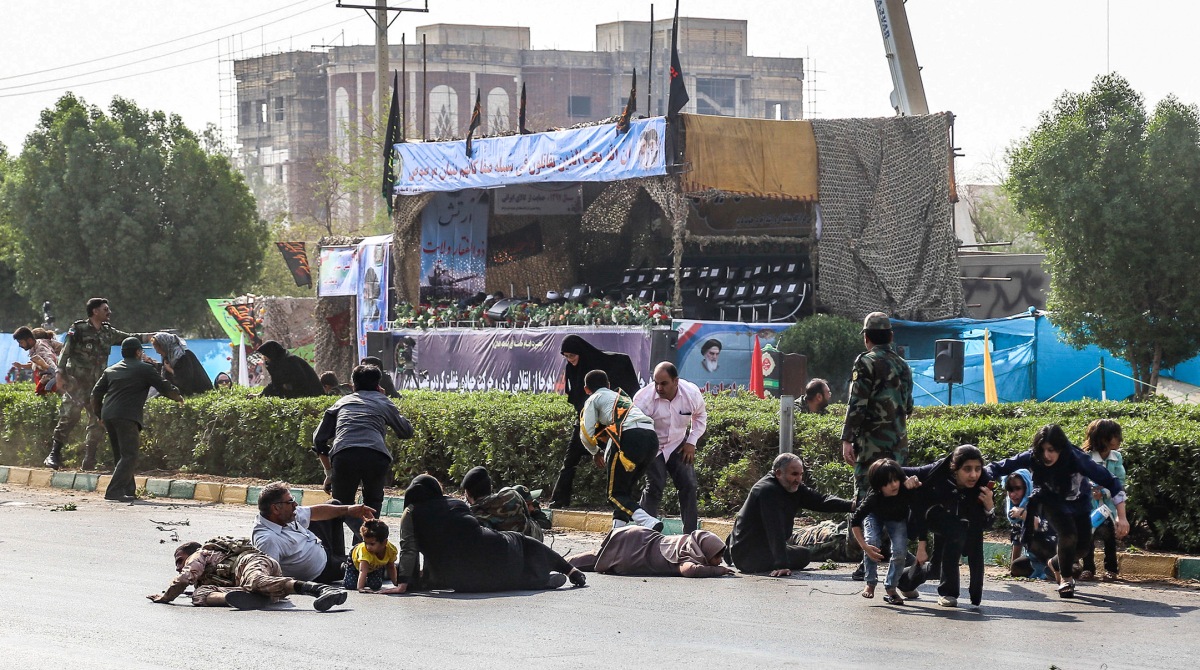Stadium ban for women to be reintroduced in Iran
A stadium ban for women is to be reintroduced in Iran, multiple local news reports said on Wednesday.

This picture taken on September 22, 2018 in the southwestern Iranian city of Ahvaz shows Iranian men, women, and children, lying on ground for and some seeking cover at the scene of an attack on a military parade that was marking the anniversary of the outbreak of its devastating 1980-1988 war with Saddam Hussein's Iraq. (Photo: AFP PHOTO / ISNA / MORTEZA JABERIAN)
In death, four-year-old Mohammad-Taha Eghdami, whose photograph went viral in Iran over the weekend, symbolises the calculated malevolence that drove terrorists to attack a military parade, killing 29 people, including conscripts and children.
Crucially enough, the parade had been organised to mark the anniversary of the start of the 1980-88 war with Saddam Hussein’s Iraq. Claims regarding responsibility are still rather fogbound with both the Islamic State of Iraq and Syria and a local terrorist group in Ahvaz, the city of occurrence, being blamed for Saturday’s outrage. Suffice it to register that the butchery does signify a Sunni onslaught on a Shia bastion, verily the deadliest that Iran has witnessed in many years.
Appropriately, therefore, President Hasan Rouhani has vowed what he calls a “crushing response” to the terrorist attack, accusing its US-backed regional rivals of “incubating insurgent separatist groups”. That strategy is much too horrific to contemplate, if at all it is contextualised with matters nuclear, Donald Trump’s withdrawal from the Western pact with Tehran, and the renewed cache of crippling sanctions on the Rouhani regime. “It is perfectly clear to us who were behind the attack and what their affiliation is,” President Rouhani said on Sunday before travelling to New York for the meeting of the UN General Assembly.
Advertisement
“The response of the Islamic Republic of Iran to the smallest threat will be crushing. Those who keep repeating their bogus stance on advocating human rights must be held accountable; all those small mercenary countries in the region which the US backs and provokes.” It will be reasonable on his part if he raises the issue at the world forum, not the least because the terrorists had targeted the elite Revolutionary Guards, indeed the pivot of Iran’s security network.
Regretfully, the UN has scarcely been able to firm up its response, let alone intiate decisive action. The narrative in Libya and Syria ~ and Myanmar ~ would have been rather different, if it did. Rouhani is yet to single out a specific country, but his government has blamed Saudi Arabia, Iran’s arch-enemy, which Tehran has accused of assisting separatist and sectarian groups. Ahvaz, the capital of Iran’s oil-rich Khuzestan province, is home to the country’s Arab minority.
The administration’s perception mirrors the stand of Iran’s supreme leader, Ayatollah Ali Khamenei ~ “This crime is a continuation of the plots of the regional states that are puppets of the United States, and their goal is to create insecurity in our dear country.” The attack was immediately claimed by an Arab nationalist separatist group called the Patriotic Arab Democratic Movement in Ahvaz. Its spokesperson told the London-based exiled TV network, Iran International, that it was aimed at “the Revolutionary Guards and the armed forces of the Islamic Republic.” A not dissimilar claim has been advanced by ISIS as well, making the outrage a two-pronged offensive.
Advertisement